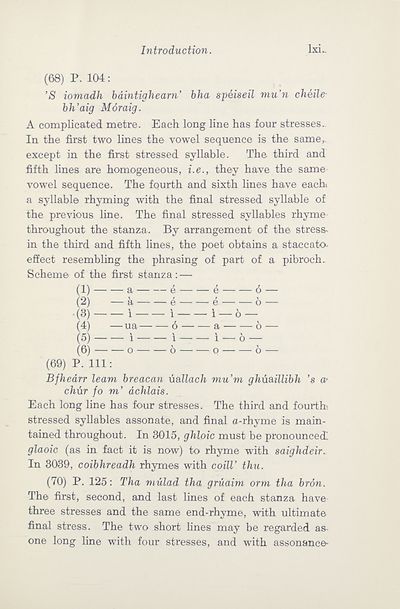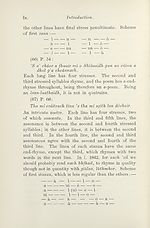Download files
Complete book:
Individual page:
Thumbnail gallery: Grid view | List view

Introduction.
IxL
(68) P. 104:
’8 iomadh bdintighearn’ bha speiseil mu'n cheile
bh’aig Moraig.
A complicated metre. Each long line has four stresses..
In the first two lines the vowel sequence is the same,,
except in the first stressed syllable. The third and
fifth lines are homogeneous, i.e., they have the same
vowel sequence. The fourth and sixth lines have eachi
a syllable rhyming with the final stressed syllable of
the previous line. The final stressed syllables rhyme
throughout the stanza. By arrangement of the stress*
in the third and fifth lines, the poet obtains a staccato,
effect resembling the phrasing of part of a pibroch.
Scheme of the first stanza: —
(1) a e & 6 —
(2) — a e e — — 6 —
(3) 1 i 1 — 6 —
(4) —ua 6 a 6 —
(5) \ 1 i — 6 —
(6) o 6 o 6 —
(69) P. Ill:
Bfhedrr team breacnn uallach mu’m ghu&illibh ’s a-
chtir fo m’ dchlais.
Each long line has four stresses. The third and fourth'
stressed syllables assonate, and final a-rhyme is main¬
tained throughout. In 3015, ghloic must be pronounced
glaoic (as in fact it is now) to rhyme with saighdeir.
In 3039, coibhreadh rhymes with coill’ thu.
(70) P. 125: Tha mulad tha gruaim orm tha bron.
The first, second, and last lines of each stanza have
three stresses and the same end-rhyme, with ultimate
final stress. The two short lines may be regarded as-
one long line with four stresses, and with assonance-
IxL
(68) P. 104:
’8 iomadh bdintighearn’ bha speiseil mu'n cheile
bh’aig Moraig.
A complicated metre. Each long line has four stresses..
In the first two lines the vowel sequence is the same,,
except in the first stressed syllable. The third and
fifth lines are homogeneous, i.e., they have the same
vowel sequence. The fourth and sixth lines have eachi
a syllable rhyming with the final stressed syllable of
the previous line. The final stressed syllables rhyme
throughout the stanza. By arrangement of the stress*
in the third and fifth lines, the poet obtains a staccato,
effect resembling the phrasing of part of a pibroch.
Scheme of the first stanza: —
(1) a e & 6 —
(2) — a e e — — 6 —
(3) 1 i 1 — 6 —
(4) —ua 6 a 6 —
(5) \ 1 i — 6 —
(6) o 6 o 6 —
(69) P. Ill:
Bfhedrr team breacnn uallach mu’m ghu&illibh ’s a-
chtir fo m’ dchlais.
Each long line has four stresses. The third and fourth'
stressed syllables assonate, and final a-rhyme is main¬
tained throughout. In 3015, ghloic must be pronounced
glaoic (as in fact it is now) to rhyme with saighdeir.
In 3039, coibhreadh rhymes with coill’ thu.
(70) P. 125: Tha mulad tha gruaim orm tha bron.
The first, second, and last lines of each stanza have
three stresses and the same end-rhyme, with ultimate
final stress. The two short lines may be regarded as-
one long line with four stresses, and with assonance-
Set display mode to:
![]() Universal Viewer |
Universal Viewer | ![]() Mirador |
Large image | Transcription
Mirador |
Large image | Transcription
| An Comunn Gàidhealach > An Comunn Gàidhealach Publications > Bardachd Ghaidhlig > (65) |
|---|
| Permanent URL | https://digital.nls.uk/126281912 |
|---|
| Description | This contains items published by An Comunn, which are not specifically Mòd-related. It includes journals, annual reports and corporate documents, policy statements, educational resources and published plays and literature. It is arranged alphabetically by title. |
|---|
| Description | A collection of over 400 items published by An Comunn Gàidhealach, the organisation which promotes Gaelic language and culture and organises the Royal National Mòd. Dating from 1891 up to the present day, the collection includes journals and newspapers, annual reports, educational materials, national Mòd programmes, published Mòd literature and music. |
|---|---|
| Additional NLS resources: |
|

